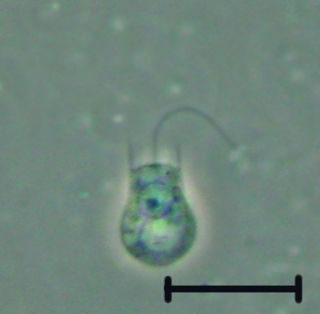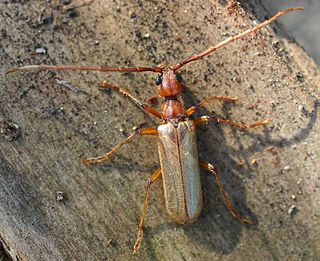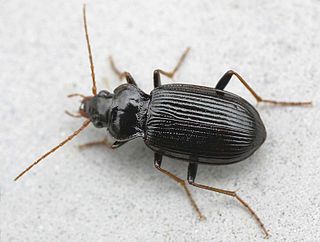
The choanoflagellates are a group of free-living unicellular and colonial flagellate eukaryotes considered to be the closest living relatives of the animals. Choanoflagellates are collared flagellates, having a funnel shaped collar of interconnected microvilli at the base of a flagellum. Choanoflagellates are capable of both asexual and sexual reproduction. They have a distinctive cell morphology characterized by an ovoid or spherical cell body 3–10 µm in diameter with a single apical flagellum surrounded by a collar of 30–40 microvilli. Movement of the flagellum creates water currents that can propel free-swimming choanoflagellates through the water column and trap bacteria and detritus against the collar of microvilli, where these foodstuffs are engulfed. This feeding provides a critical link within the global carbon cycle, linking trophic levels. In addition to their critical ecological roles, choanoflagellates are of particular interest to evolutionary biologists studying the origins of multicellularity in animals. As the closest living relatives of animals, choanoflagellates serve as a useful model for reconstructions of the last unicellular ancestor of animals.

Sigilmassasaurus is a possibly dubious genus of spinosaurid dinosaur that lived approximately 100 to 94 million years ago during the Late Cretaceous Period in what is now northern Africa. Named in 1996 by Canadian paleontologist Dale Russell, it contains a single species, Sigilmassasaurus brevicollis. The identity of the genus has been debated by scientists, with some considering its fossils to represent material from the closely related species Spinosaurus aegyptiacus, while others have classified it as a separate taxon, forming the clade Spinosaurini with Spinosaurus as its sister taxon.

The Asian parti-colored bat is a species of parti-coloured bat. An adult Asian parti-colored bat has a body length of 6–7 cm (2.4–2.8 in), a tail of 4.3–4.5 cm (1.7–1.8 in), and a wing length of 5 cm (2.0 in). Asian parti-colored bats are distributed across East Asia, from Taiwan through eastern China, eastern Mongolia and Russia (Siberia) to the Korean Peninsula and Japan.
Nitrile hydratases are mononuclear iron or non-corrinoid cobalt enzymes that catalyse the hydration of diverse nitriles to their corresponding amides
The dark-brown serotine is a species of vesper bat found in Central and West Africa.

The Vesperidae are a small family of beetles, normally classified within the family Cerambycidae, of heterogeneous aspect but all characterised by larval stages related to roots of herbaceous plants or trees

Nebria brevicollis is a species of ground beetle native to Europe and the Near East. In Europe, it is found in all countries and islands except the Azores, the Canary Islands, the Channel Islands, Franz Josef Land, Gibraltar, Madeira, Malta, Monaco, the North Aegean Islands, Novaya Zemlya, San Marino, the Selvagens Islands, Svalbard and Jan Mayen, and Vatican City. It has now been reported as introduced in western Oregon, U.S.A., where it has been found in highly disturbed sites as well as in native old-growth forest stands. It has also now been found in Washington State, Northern California, as well as in Southern British Columbia, Canada(See external link to iNaturalist, below). This species is most abundant between October and December, then from January through mid-May. Although Nebria brevicollis is widely considered to be solely carnivorous, multiple small studies made by enthusiasts have proven that many Nebria brevicollis will resort to eating various types of fungi that can be found in the soil they live on/around. Studied made by the same individuals have also shown that Nebria brevicollis are semi-social, and will often work together when faced with certain obstacles.
Vesperus sanzi is a species of beetle in the Vesperidae family that can be found in Portugal and western Spain.
Vesperus serranoi is a species of beetle in the Vesperidae family that is endemic to the Iberian Peninsula.

Vesperus strepens is a species of brown coloured beetle in the family Vesperidae, found in France and Italy.
Vesperus xatarti is a species of brown coloured beetle in the family Vesperidae, found in the Balearic Islands, France, and Spain.

Vesperus luridus is a species of beetle in the Vesperidae family
Vesperus conicicollis is a species of brown coloured beetle in the family Vesperidae, found in Portugal, Spain, and on the island of Sardinia.
Perilitus brevicollis is a species of parasitoid wasp in the family Braconidae. The host of this wasp is the blue willow beetle, which is a pest in Europe.

Vesperus is a genus of beetles in the family Vesperidae.
Malacocis brevicollis is a species of minute tree-fungus beetle in the family Ciidae. It is found in North America.
Notiobia brevicollis is a species of ground beetle in the family Carabidae. It is found in North America.
Neoromicia grandidieri, known by the common names of Dobson's pipistrelle and yellow pipistrelle, is a species of vesper bat found in Africa. It was formerly in the genus Pipistrellus

Trachylepis brevicollis, the short-necked skink or Sudan mabuya, is a species of skink found in Sudan, Ethiopia, Eritrea, Somalia, Kenya, Uganda, Tanzania, Yemen, Saudi Arabia, and Oman.

Carex brevicollis is a species of sedge, found in Spain, France, Slovakia, Hungary, Romania, Bulgaria, Ukraine, the former Yugoslavia, Anatolia, the north Caucasus, and the Transcaucasus. It prefers to grow in calcareous mountain grasslands.







